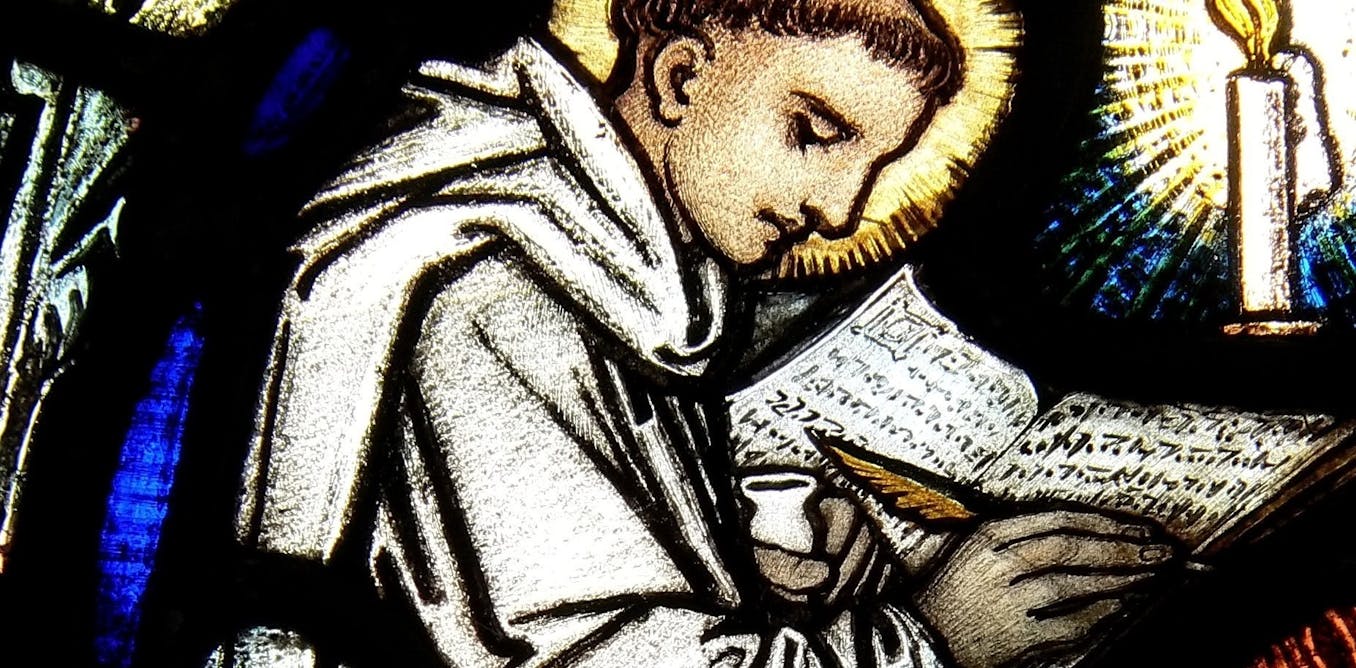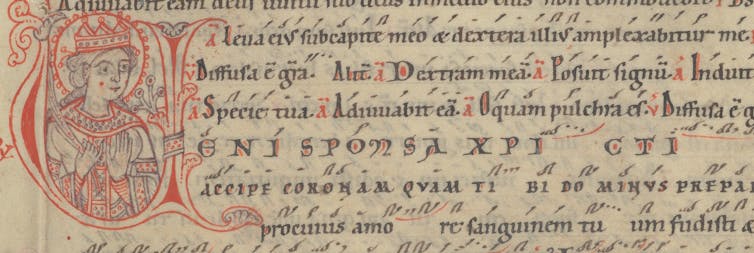From scribe to choir to being repurposed over generations, medieval Christian chant book fragments reveal stories
Piecing together the mystery of medieval chant books means studying hand-made objects from centuries ago.


Medieval chant books and the parchment they were made of were designed to last a long time — so long, that pages of them can outlast the book itself. Across medieval Europe, monks and nuns and clergy in city cathedrals sang daily chants in communal forms of timed and sung prayer still practised by some Christians today. Fragments of chant books travel across time and space, ending up at antique stores, tucked away in attics or even made into book covers.
Our research collects images of these scattered and fragmented pages of chant and creates inventories of their contents, revealing their many and varied stories.
Why chant?
Medieval Christian communities wrote down the many chants needed for their worship in books called antiphoners (music only), breviaries (which also included texts to be read) and graduals (containing chants that were part of the mass, the central act of worship in the Catholic Church).
Each chant was intended to be sung at a particular time or occasion, and rarely did two communities do things exactly alike. Medieval chant books followed similar patterns, but could also be surprisingly different from one another.
One monastery might sing a certain chant in the morning, while the nearby cathedral might sing it in the afternoon with a slightly different melody or celebrate a saint of local importance on that day instead. Taken together, such decisions can often be a kind of fingerprint for a manuscript. They can make it possible to identify where a book might have been from.
Reuniting lost books
Many books didn’t survive intact. Some were taken apart once their contents were no longer useful to their communities, or disassembled by booksellers hoping to make more money by selling the book page-by-page. One of the goals of our research is to make the contents of these individual pages easier to access, so that they can be better understood.
Sometimes it is possible to reunite a book’s pages again, especially if there is a clue about when and where the pages were last seen together.
For example, in the mid-20th century, American art history professor Otto Ege of the Cleveland Institute of Art took apart many books. Ege rearranged their pages into bundles of 50 to sell to libraries; this way, he reasoned, library collections could have examples of many different kinds of manuscripts.
Now, it is possible to undo some of Ege’s book-breaking, by gathering up pictures of the pages he sold and re-ordering them digitally.
Abbey library mystery
A slightly different case is the Gottschalk Antiphoner, a beautifully decorated 12th-century chant book from Lambach Abbey in Austria, which was eventually taken apart and used to bind books for the abbey’s library.
Many of these bindings were sold to collectors during the Second World War, but thanks to extensive scholarly sleuthing, 30 of the pages have been put together digitally, making it possible to get a better glimpse of this remarkable volume.
But often what has been broken is not readily put together again. Hundreds of pages of the Gottschalk Antiphoner, and of Ege’s collections, remain at large.

Windows into the past
So, if the pages cannot be put back into their books, what can be said about them? In the absence of the rest of the book, small details of each page become more remarkable.
Even one page, which typically only contains the music and texts for a small part of the day, can reveal some small choices in wording or melodies, providing clues to its origins. And even when the clues go nowhere, they provide a window into a small piece of the past: the unique way that that community chose to celebrate.
Eage page is a hand-made object, and reveals something about the people who made it. We have seen pages where an inattentive scribe forgot to include a letter or a note; another page is hand-stitched where someone carefully fixed a tear in the parchment.
Page references were added in or changed as the book was used. Some pages are plain, others purposefully illustrated while others are whimsical. Among the hundreds of pages of an entire chant book, such details can go overlooked, but in isolation, they are a picture of a particular day in the working life of a scribe, illustrator or musician.
Pages’ afterlives
Just as often, the fragments are interesting not just for where they began, but where they ended up, and how they got there.
Through our research, we’ve heard how one page, after arriving in Nova Scotia, was passed along through several people connected to the local symphony, tracing a story of friendships in a musical community.
Another fragment had been repurposed as the cover of a book, providing a glimpse into religious reforms. An early owner had written the titles of Lutheran hymns in between the older chants.
The individual personalities associated with each fragment sometimes come to the fore in delightful ways. One arrived with a letter describing how the letter-writer had fallen in love with the fragment while her family was temporarily installed in West Germany. The fragment was found in a shop adjacent to the many stalls selling glühwein (warm, spiced wine) and cuckoo clocks in a busy Christmas market.
Such stories are reminders that even in the absence of larger books, pages have individual journeys. From the time they were crafted to their paths into the 21st century, each is the product of individual choices set against the backdrop of historical changes and institutions — a page from a much bigger book.![]()
Jennifer Bain receives funding from the Social Sciences and Humanities Research Council of Canada.
Anna de Bakker does not work for, consult, own shares in or receive funding from any company or organisation that would benefit from this article, and has disclosed no relevant affiliations beyond their academic appointment.
What's Your Reaction?






























































































